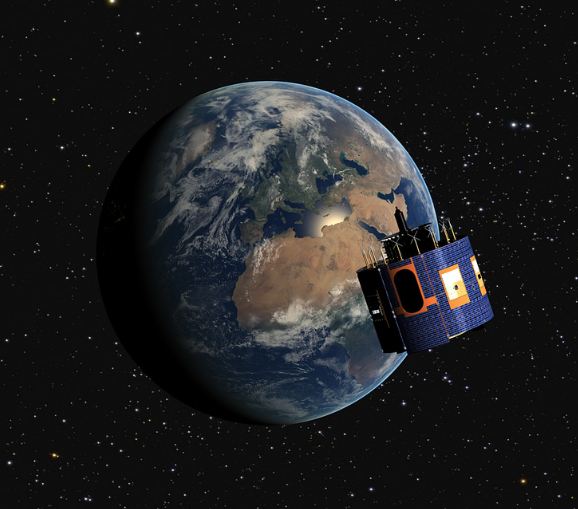
Artist's impression of MSG-4
[SatNews] EUMETSAT’s fourth Meteosat Second Generation (MSG-4) satellite is being shipped to French Guiana for a July 2, 2015 launch from Kourou, the European Space Port.
The MSG series of geostationary satellites is vital to ensure the safety of lives, property and infrastructure, through its critical value for the nowcasting of high impact weather. They are operated as a two-satellite system providing both full disc imagery over Europe and Africa every 15 minutes and rapid scan imagery over Europe only every five minutes.
MSG-4 will be stored in orbit after launch and commissioning. As Meteosat-11, it will ultimately bridge the gap between Meteosat-10 (launched in 2012) and the first MTG satellites, expected to be launched in 2019 and 2021.
Once operational, MSG-4 (Meteosat-11) will also expand the 35-year climate records accumulated by the Meteosat series since 1981.
MSG-4 is the last of the MSG satellites resulting from the successful cooperation model with the European Space Agency (ESA), which is responsible for the development of satellites fulfilling user and system requirements defined by EUMETSAT and for the procurement of recurrent satellites on its behalf. EUMETSAT develops the ground systems required to deliver products and services to users and to respond to their evolving needs. It also procures all launch services and operates the full system for the benefit of users.
All MSG satellites are manufactured by a European consortium led by Thales Alenia Space.
Two generations of active Meteosat satellites, Meteosat First Generation (MFG) and Meteosat Second Generation (MSG), providing images of the full Earth disc, and data for weather forecasts.
Meteosat weather satellites of the first and second generations have been delivering weather and climate data for Europe and beyond, from geostationary orbit 36,000 kilometers above the Earth’s surface, since 1977.
The data provided by Meteosat satellites make a vital contribution to daily weather forecasting, in particular for nowcasting and very short range forecasting of high impact weather.
The operational imagery services over Europe and Africa, are now exclusively provided by Meteosat Second Generation (MSG) satellites, and are based on their optimum use as a two-satellite system: one satellite provides full disc imagery of the European and African continents and parts of the Atlantic and Indian oceans every 15 minutes, while the second delivers more frequent images every five minutes (Rapid Scanning Service) over Europe only, to further support warnings of localized high-impact weather such as thunderstorms and fog.
The last satellite of the first generation is still functional and has been moved to 57.5 degrees East, over the Indian Ocean, where it will fill an observational gap until it runs out of fuel, probably in 2017.
From 2018 onwards, Meteosat Third Generation (MTG) will gradually replace MSG, to continue providing support to nowcasting and very short range forecasting.The requirements of the new MTG system have been developed in dialoguewith users and in consultation with remote sensing and forecast experts. To meet these requirements, the MTG spacecraft will deliver major enhancements to the MSG imagery mission, including lightning imagery, but also, for the first time ever from the geostationary orbit, hourly observations of vertical profiles of temperature and humidity in the atmosphere.
These “soundings” will bring critical input to high resolution regional numerical models expected to be used for nowcasting purposes in the 2020 timeframe

